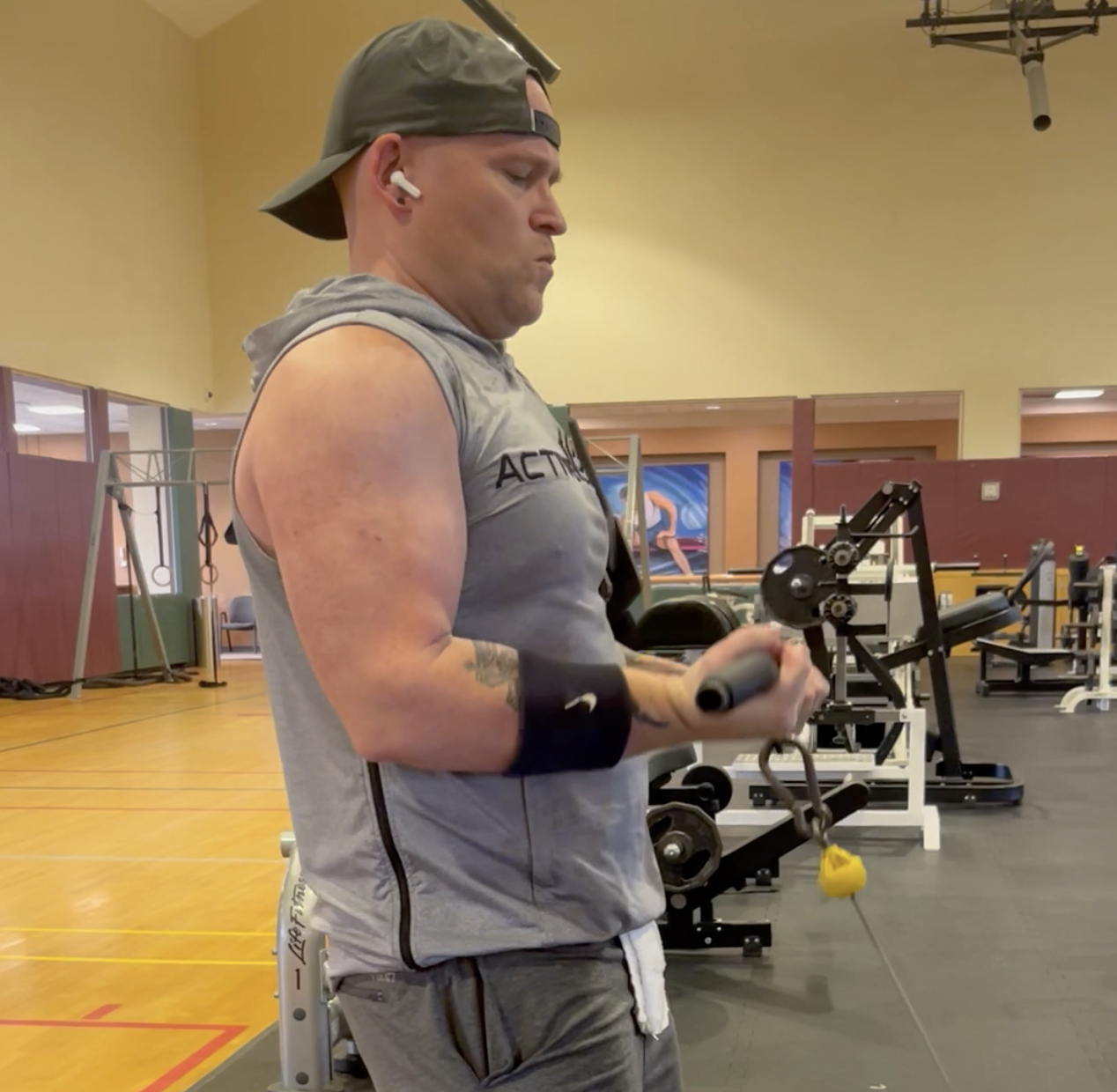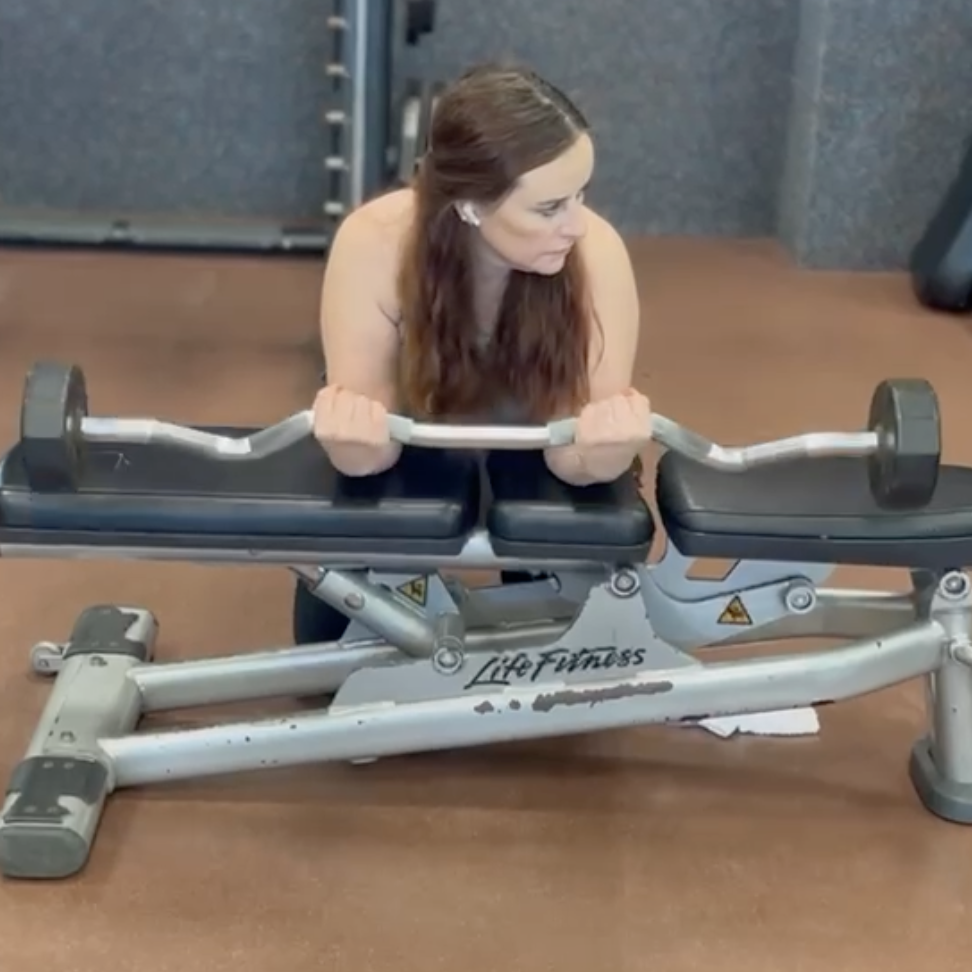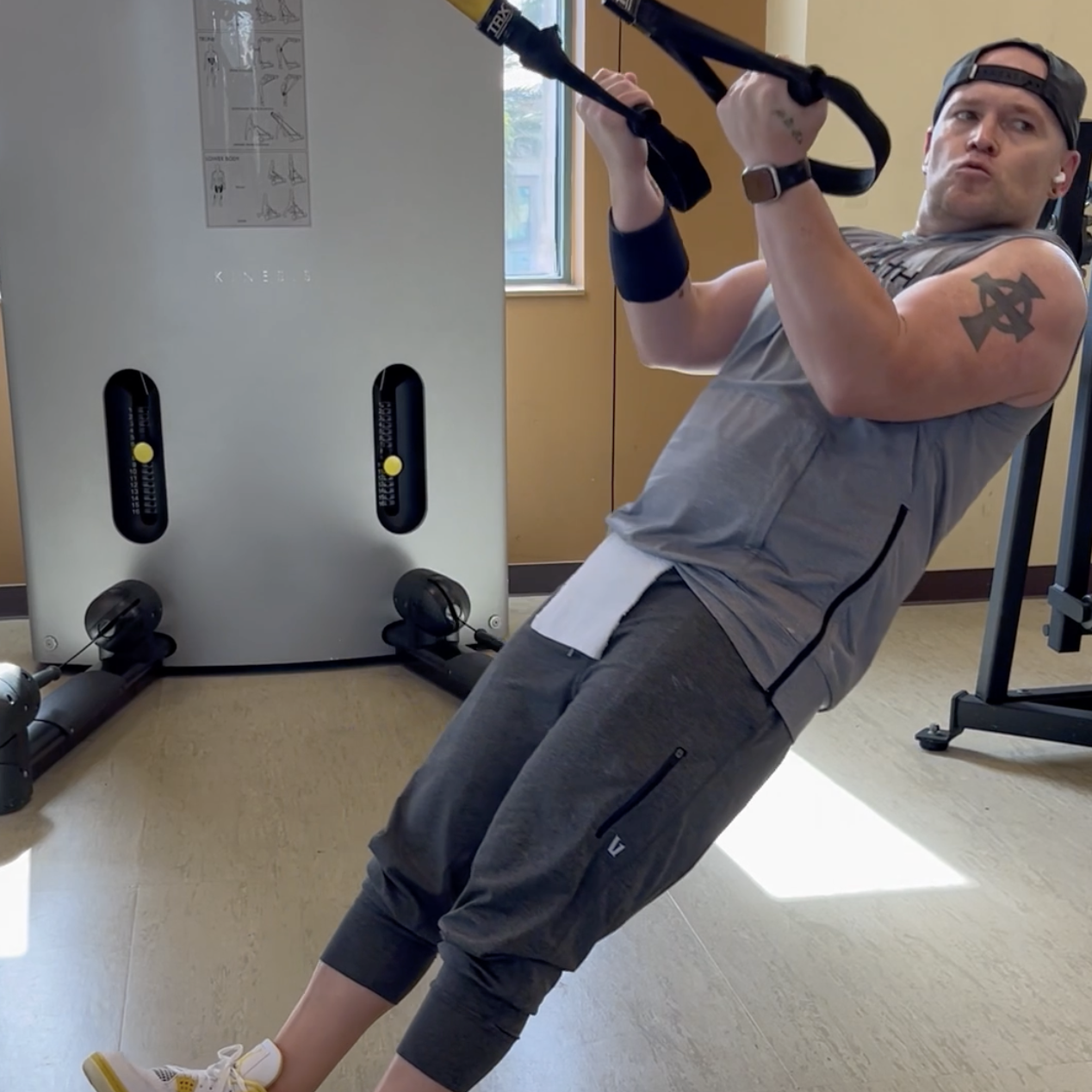Bicep Workout 3
#BicepWorkout
Instructions:
Warm Up
✅ Start with a weight that is easy and does not cause strain or heavy breathing.
Reverse Pyramid
✅ On your first heavy weight: Do a weight that you can do 4-6 reps. Then decrease the weight by 10% for each of the following reps. Once you hit the max you can do, increase your weight. Rinse and repeat as you get stronger.
Rest Pause
✅ Rest Pause is 4 Rounds. The first set is larger and the other three are smaller. The weight stays the same for all rounds. If you can do 12 Reps and 6 Reps with only 15 seconds of rest easily, then increase the Rep count to 14 and 7.
Abs
✅ You have Two Options: Option 1: You can do 1 Set of 60 OR Option 2: 3 Sets of 20 (you can mix it in between the exercises as you do the workout)
The Workout
1. Standing Cable Curl (Reverse Pyramid)
Example: (adjust weight according to what works best for you)
Warm up: 4-6 Reps: 30 pounds (then do 1 minute rest)
Warm up: 4-6 Reps: 40 pounds (then do 2 minute rest)
Round 1 – Do 4-6 Reps: 60 pounds (then do 3 minute rest)
Round 2 – Do 6-8 Reps: 50 pounds (then do 3 minute rest)
Round 3 – Do 8-10 Reps: 40 pounds (then do 3 minute rest)
2. Standing Cable Curl (Rest Pause)
Example: (adjust weight according to what works best for you)
Round 1 – Start at 12 Reps for your first set (then do 15 second rest)
Round 2 – Do 6 Reps (then do 15 second rest)
Round 3 – Do 6 Reps (then do 15 second rest)
Round 4 – Do 6 Reps (then do 15 second rest)
3. Standing Dumbbell Concentration Curl (Reverse Pyramid)
Example: (adjust weight according to what works best for you)
Warm up: 1 lap: 30 pounds (then do 1 minute rest)
Warm up: 1 lap: 40 pounds (then do 2 minute rest)
Round 1 – 1/2 Lap: 60 pounds (then do 3 minute rest)
Round 2 – 1 lap: 50 pounds (then do 3 minute rest)
Round 3 – 1 lap: 40 pounds (then do 3 minute rest)
4. Standing Dumbbell Concentration Curl (Rest Pause)
Round 1 – Start at 1 Lap for your first set (then do 15 second rest)
Round 2 – Do 1/2 Lap (then do 15 second rest)
Round 3 – Do 1/2 Lap (then do 15 second rest)
Round 4 – Do 1/2 Lap (then do 15 second rest)
5. Underhand Grip Inverted Row (Rest Pause)
Round 1 – Start at 1 Lap for your first set (then do 15 second rest)
Round 2 – Do 1/2 Lap (then do 15 second rest)
Round 3 – Do 1/2 Lap (then do 15 second rest)
Round 4 – Do 1/2 Lap (then do 15 second rest)
6. Barbell Wrist Curl (Rest Pause)
Example: (adjust weight according to what works best for you)
Round 1 – Start at 12 Reps for your first set (then do 15 second rest)
Round 2 – Do 6 Reps (then do 15 second rest)
Round 3 – Do 6 Reps (then do 15 second rest)
Round 4 – Do 6 Reps (then do 15 second rest)
6. Abs: Swiss Ball V-Up and Pass
Two Options:
Option 1: Set of 60 (each side)
Option2: 3 Sets of 20 (each side) – You can mix it in between the exercises as you do the workout.
7. Abs: Gray Bench Weighted Crunch
Two Options:
Option 1: Set of 60
Option2: 3 Sets of 20 – You can mix it in between the exercises as you do the workout.




Bicep Workout 3
Bicep workouts are an essential component of any strength training regimen. Whether you’re trying to increase arm size, enhance your physical performance, or improve your overall muscle tone, training the biceps effectively is crucial. The biceps are one of the most visible muscle groups on the body, and a well-developed set of arms is often associated with physical strength and fitness. Building the biceps through targeted exercises like the Standing Cable Curl, Standing Dumbbell Concentration Curl, Underhand Grip Inverted Row, and Barbell Wrist Curl can help you achieve your fitness goals. These exercises not only improve muscle mass but also boost functional strength, improve posture, and contribute to your performance in other lifts and athletic activities.
Why Bicep Workouts Are Important
The biceps are composed of two main muscles: the long head and the short head. Together, these muscles help with elbow flexion and forearm supination, which are movements that occur when you bend your arm or rotate your palm upward. Because the biceps are involved in a variety of everyday movements, training them strengthens these muscle groups and improves your ability to perform daily tasks like lifting, carrying, or pushing.
Additionally, having strong biceps plays a role in enhancing your performance in other exercises. For example, when you perform back exercises like pull-ups, rows, or deadlifts, the biceps help support the movement by assisting in pulling and gripping motions. Well-developed biceps are also beneficial for exercises that involve pushing, such as bench presses or shoulder presses, as they play a stabilizing role in these lifts.
Bicep workouts are also great for aesthetic purposes. Strong, defined biceps are often associated with physical attractiveness and muscularity. For bodybuilders, having a balanced physique that includes well-developed biceps is crucial to achieving symmetry. Even for those focused on general fitness, working on biceps can help improve overall muscle tone and definition, contributing to a well-rounded physique.
Training your biceps also helps with muscle endurance and can improve overall performance in cardio and endurance exercises. Many sports, including swimming, rock climbing, and boxing, require strong arm muscles. In these sports, the biceps are often activated in combination with other upper body muscles, helping you maintain stamina, strength, and mobility throughout your workout or sport.
Key Exercises for Bicep Development
Standing Cable Curl
The Standing Cable Curl is an excellent exercise for targeting the biceps. Unlike dumbbells or barbells, cables provide constant tension throughout the movement, which allows for a more consistent activation of the muscle fibers in the biceps. When you perform a Standing Cable Curl, the cable machine ensures that your muscles stay engaged from start to finish, making it more challenging than some other bicep exercises.
To perform the Standing Cable Curl, start by setting the cable machine to the lowest setting and attach a straight bar or rope. Stand with your feet shoulder-width apart, and grasp the bar with both hands using an underhand grip. Keep your elbows close to your sides and slowly curl the bar toward your chest, focusing on contracting your biceps as you lift. Make sure to avoid swinging your body or using momentum to pull the weight up; instead, keep your movements controlled. Lower the bar back down in a slow and controlled motion, maintaining tension in the cable throughout.
The constant tension provided by the cable machine forces your biceps to work harder, which can lead to greater muscle growth. This exercise also allows for a full range of motion, which is essential for muscle development. By focusing on strict form and full contraction, you can maximize the effectiveness of the Standing Cable Curl.
Standing Dumbbell Concentration Curl
The Standing Dumbbell Concentration Curl is a great exercise for isolating the biceps and focusing on building strength and size in the muscle. Unlike compound movements, which engage multiple muscle groups at once, concentration curls allow you to focus solely on the biceps, which is particularly beneficial for those looking to increase muscle definition or size.
To perform this exercise, stand with your feet shoulder-width apart and hold a dumbbell in one hand. Lean forward slightly and place your elbow against the inside of your thigh for support. Keeping your upper arm stationary, curl the dumbbell upward toward your shoulder, squeezing your bicep at the top of the movement. Lower the dumbbell back down slowly, maintaining control throughout. Repeat for the desired number of reps before switching arms.
The concentration curl is especially effective for targeting the peak of the bicep, helping to create a more defined, sculpted look. The isolation aspect of this exercise allows for maximum contraction and full engagement of the biceps. Because you’re working one arm at a time, this exercise can also help correct any imbalances between your left and right biceps.
Underhand Grip Inverted Row
The Underhand Grip Inverted Row is a compound exercise that targets the biceps along with other upper body muscles like the back, shoulders, and forearms. While the inverted row is traditionally seen as a back exercise, using an underhand grip changes the angle of the movement, placing more emphasis on the biceps.
To perform the Underhand Grip Inverted Row, set up a barbell on a squat rack or Smith machine at about waist height. Lie under the bar and grasp it with an underhand grip (palms facing you). Keep your body in a straight line, engage your core, and pull your chest toward the bar, squeezing your shoulder blades together as you lift. Lower yourself back down in a controlled motion, and repeat. To increase difficulty, you can add weight to your body or elevate your feet.
The Underhand Grip Inverted Row is particularly effective for building functional strength in the biceps because it simulates a pulling movement. Since the biceps play a crucial role in pulling motions, exercises like this one help improve your ability to perform a variety of activities that require strength and endurance.
Barbell Wrist Curl
The Barbell Wrist Curl is an exercise that focuses on the forearms but also indirectly targets the biceps. Strong forearms are essential for gripping and stabilizing during many exercises, and the wrist curl is one of the best movements for developing these muscles. By strengthening your forearms, you can improve your overall grip strength, which will translate into better performance in exercises like deadlifts, pull-ups, and rows.
To perform the Barbell Wrist Curl, sit on a bench with your forearms resting on your thighs. Hold a barbell with both hands, palms facing up. Allow the barbell to roll down to your fingertips and then curl it back up by flexing your wrists. Focus on slow, controlled movements to fully engage your forearm muscles. You can also perform reverse wrist curls (palms facing down) to target different areas of the forearms and achieve a balanced workout.
Wrist curls are often overlooked in traditional bicep training, but they are vital for building overall arm strength and enhancing your ability to perform other lifting movements. Additionally, strong forearms contribute to better posture and injury prevention.
Benefits of Bicep Workouts
Bicep workouts offer a wide range of benefits, both aesthetic and functional. These workouts help improve arm strength, muscle definition, and endurance. They also contribute to improved performance in other lifts and athletic activities. Below are some of the key benefits of bicep workouts:
Injury Prevention Strengthening the biceps and forearms helps reduce the risk of injury by improving stability and joint health. Stronger muscles around the elbow joint can protect against strains, sprains, and other injuries. Additionally, improved grip strength reduces the likelihood of dropping weights, which could lead to injury., even when the going gets tough.
Increased Arm Strength and Size Regular bicep training leads to increased muscle mass and strength in the arms. This can improve your performance in exercises like pull-ups, rows, and deadlifts, where the biceps play a supporting role. A stronger set of arms also translates into better functional strength for activities like lifting groceries, carrying heavy objects, or performing manual labor.
Improved Posture Bicep workouts help improve posture by strengthening the muscles in the upper body, including the shoulders, back, and arms. By developing the biceps and surrounding muscles, you can promote better alignment of the spine, reducing the risk of slouching or rounding your shoulders. Improved posture can also alleviate back pain and contribute to overall body alignment.
Enhanced Grip Strength Many bicep exercises, like the wrist curl and inverted row, improve grip strength by targeting the muscles in the forearms. A stronger grip can improve your ability to hold onto weights during exercises, enhance your performance in sports like rock climbing, and make everyday tasks like carrying heavy bags easier.
Better Aesthetics Well-developed biceps contribute to a more muscular and balanced physique. As one of the most visible muscle groups, the biceps play a significant role in the overall appearance of your arms. Sculpted biceps can enhance your physical appearance and make you feel more confident about your body.
Incorporating bicep exercises like the Standing Cable Curl, Standing Dumbbell Concentration Curl, Underhand Grip Inverted Row, and Barbell Wrist Curl into your workout routine can help you build strong, functional, and aesthetically pleasing arms. These exercises target different areas of the biceps and forearms, allowing for balanced muscle development. Whether you’re looking to increase strength, improve endurance, or enhance muscle definition, bicep workouts play an essential role in achieving your fitness goals. Consistency, proper form, and progressive overload are key to maximizing the benefits of these exercises, helping you build the strong, defined arms you desire.
